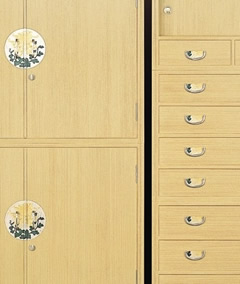KAMO Kiri Tansu (Paulownia Chests)

The first Kamo paulownia chest was made by a carpenter in the early 19th century, and the very same chest, which has “Purchased 1814” inscribed on the back, is still being used in the city of Kamo today.
The present look of Kamo paulownia chests dates back to 1928 with the development of yashatoso varnish. Today, 70% of the paulownia chests made in Japan are produced Kamo and shipped all over the country.
Paulownia is a lightly colored wood with a silk-like sheen. The quarter-sawn boards used to make Kamo paulownia chests look as though they have been lightly streaked with brown paint. The woodgrain has a beauty unmatched by any other material used in furniture. The perfectly fitted drawers open and close with ease, protecting their contents from extreme temperatures.
Feature
Kamo chests are made from paulownia wood, which has a beautiful white luster and the same sense of quiet refinement as silk. The straight, dark brown woodgrain, which looks as if it were painted by a brush, creates an elegant feeling not found in any other wooden furniture. While the drawers open and close with ease, they form a nearly hermetic seal when shut, keeping clothes safe from both heat and humidity.
How to make
The preparation of the wood requires milling, resin removal, and drying for nearly three years. The entire assembly process, which consists of joining the boards, planing, assembling the mortise and tenon joints and attaching the metalwork decorations, is performed entirely by hand. It is a truly impressive sight to see the artisans working with their chisels and planes to create a product of such beauty and refinement.

